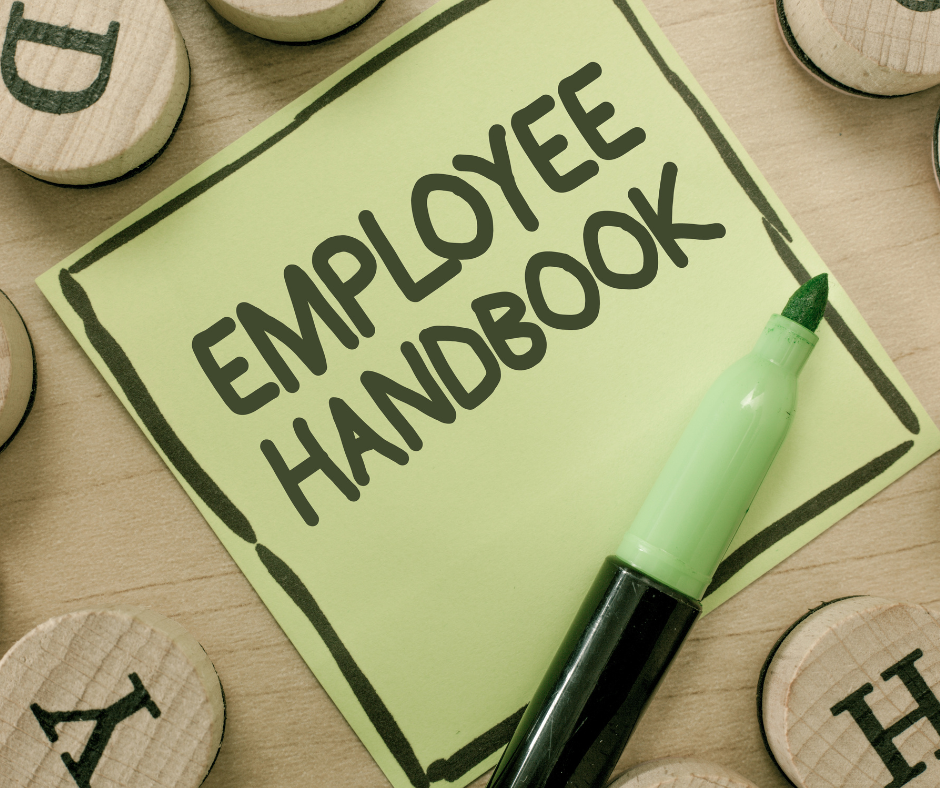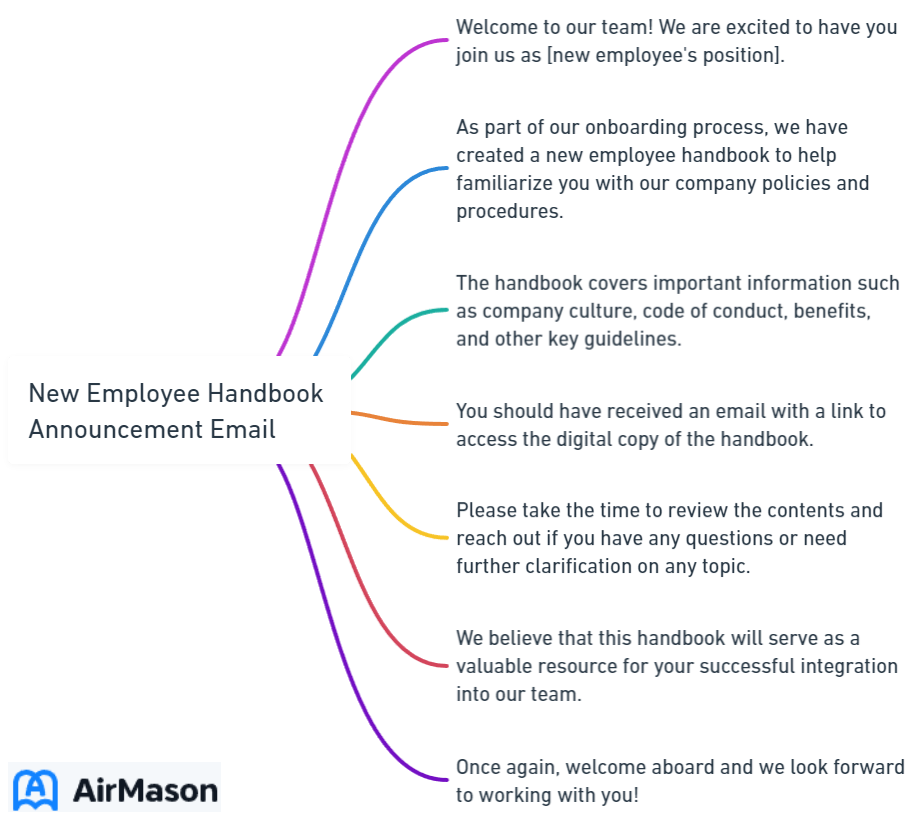
Dear employees,
Introducing a new employee handbook is an essential step in ensuring that employees have access to important information about company policies, procedures, and expectations. Crafting a compelling subject line for this announcement email is crucial as it captures your attention, sets the tone for the message, and clearly conveys the purpose of the email. The new employee handbook announcement email serves as a formal communication to inform employees about the availability of the handbook and the key information it contains. The aim is to provide clarity, consistency, and promote employee engagement and productivity within the organization.
The employee handbook plays a pivotal role in fostering a positive work environment and establishing a strong company culture. Its importance lies in several key areas including:
- Ensuring Consistency and Fairness: The handbook sets clear guidelines and expectations for all employees, ensuring consistency and fairness in how policies and procedures are applied.
- Outlining Company Policies and Procedures: It serves as a comprehensive guide, outlining the company’s policies, procedures, and guidelines, helping employees understand what is expected of them and how to navigate various work-related situations.
- Promoting Employee Engagement and Productivity: The handbook can include information on employee benefits, development opportunities, and resources, encouraging employee engagement and enhancing overall productivity.
Within the employee handbook, employees can expect to find a wide range of information that is relevant to their role and employment. This may include:
- Company Background and Mission Statement: Providing an overview of the company’s history, values, and mission, helping employees connect with the organization’s purpose.
- Employee Rights and Responsibilities: Outlining the rights and responsibilities of employees, including information on working hours, breaks, and other important legal and ethical aspects of their employment.
- Code of Conduct and Ethics: Defining the expected behavior and ethical standards for employees in their interactions with colleagues, customers, and stakeholders.
- Benefits and Compensation: Detailing the company’s benefits package, including information on health insurance, retirement plans, and other employee perks.
- Leave and Time-Off Policies: Outlining policies related to vacation leave, sick leave, parental leave, and other types of time-off.
- Performance Expectations and Review Process: Communicating the company’s performance expectations, including performance evaluation processes and feedback mechanisms.
Accessing the employee handbook should be made easy for employees. It may be available in a digital format, such as a PDF file, or accessible through an employee portal or intranet. The communication should provide clear instructions on how employees can access and familiarize themselves with the handbook.
By announcing the availability of the new employee handbook, the company can ensure that employees are well-informed, aligned with organizational values, and equipped with the necessary knowledge to thrive in their roles.
Key Information about the Employee Handbook
The Employee Handbook is a comprehensive document that includes the company’s policies on various topics such as attendance, dress code, communication, and conflict resolution. It provides key information about company policies, procedures, and expectations. Here’s an example of an employee handbook for a restaurant. It serves as a guide for employees, outlining their rights, responsibilities, and code of conduct. The handbook ensures consistency and fairness throughout the organization by clearly stating policies and procedures, which creates a level playing field. It also promotes employee engagement and productivity by aligning behavior with company expectations and values. According to a study by the Society for Human Resource Management (SHRM), organizations with comprehensive employee handbooks have lower turnover than those without them. Incorporating employee feedback into the development of the handbook is crucial to ensure it meets the needs and addresses the concerns of the workforce, fostering a collaborative and trusting work environment.
Importance of the Employee Handbook
In the dynamic world of employee onboarding, the importance of a well-crafted employee handbook in keeping employees informed about changes in the company’s policies cannot be understated. It serves as a key aspect of organizational success, ensuring consistency and fairness, outlining essential company policies and procedures, and promoting employee engagement and productivity through clear and concise communication. The human resources department plays a pivotal role in ensuring the handbook effectively communicates company policies to all employees, including updates on vacation days, dress code, compensation, and sick time, thereby setting the stage for a thriving and cohesive work environment. Let’s dive into the vital role that an employee handbook plays in fostering transparent and effective operations within the organization.

Ensuring Consistency and Fairness
Ensuring consistency and fairness is crucial for creating and implementing an employee handbook. It is important to incorporate a fair and equitable work environment for all employees.
Here are 9 ways to ensure consistency and fairness:
– Develop clear policies and procedures that outline expectations and standards for all employees, thus ensuring consistency and fairness. – Apply these policies consistently across the organization to avoid any form of favoritism or bias, which can hinder consistency and fairness. – Communicate the policies and procedures effectively to all employees, ensuring everyone is aware of their rights, which helps in maintaining consistency and fairness. – Provide training and resources to help employees understand and comply with the policies, contributing to consistency and fairness. – Create a mechanism for employees to voice concerns or provide feedback regarding policy implementation, thus promoting consistency and fairness. – Regularly review and update policies to align with legal requirements and industry best practices, ensuring ongoing consistency and fairness. – Establish a fair and transparent disciplinary process that is consistently applied to all employees, fostering consistency and fairness. – Offer equal opportunities for advancement and development based on merit, rather than personal preferences, promoting consistency and fairness. – Providing advance notice of policy changes as a fundamental HR practice, emphasizing the importance of allowing employees to adapt and minimizing the risk of non-compliance, thus ensuring consistency and fairness.
Enforcing consistency and fairness not only creates a positive work environment but also builds trust and loyalty among employees.
Outlining Company Policies and Procedures
- Clear communication: The employee handbook outlines company policies and procedures for all employees. It ensures that everyone understands expectations. Notifying employees about these policies through various methods such as print and mail automation, electronic distribution, emails, meetings, and physical copies is crucial to maintain transparency and a positive employer-employee relationship. Effective communication strategies, including highlighting changes, sending out email or direct mail campaigns, and providing sample templates for policy change letters and emails, are essential to ensure employees are well-informed and aligned with company expectations.
- Consistency: Outlining policies and procedures promotes fairness and avoids biases. It fosters consistency in how different situations are handled.
- Governance: The handbook acts as a reference guide for employees to understand organizational guidelines and rules. It provides clarity on processes like performance evaluations and conflict resolution.
- Legal compliance: Outlining policies and procedures ensures compliance with legal requirements and regulations. Topics like anti-discrimination policies, health and safety guidelines, and data protection are addressed.
- Efficiency and productivity: Clear policies and procedures enhance workplace efficiency and productivity. Employees understand how to complete tasks, follow protocols, and seek approvals.
- Adaptability: Outlined policies and procedures allow for easy updates and revisions as the organization evolves. Notifying employees as a continuous process keeps them updated on any changes or additions, ensuring they are aware of new expectations and guidelines.
Pro-tip: Use clear language and provide examples or scenarios in the employee handbook to help employees understand and apply policies in their daily work.
Promoting Employee Engagement and Productivity
To promote employee engagement and productivity, the employee handbook is crucial. It serves as a comprehensive guide that clearly outlines the company’s expectations and goals. This helps employees align their efforts with these objectives, ultimately fostering a more productive work environment.
The handbook also plays a vital role in establishing transparent communication channels, such as team meetings and feedback mechanisms. These channels enhance engagement and ensure that employees feel valued, respected, and listened to by the organization.
Moreover, a well-developed employee handbook goes beyond communication and addresses important aspects like work-life balance, diversity, and inclusion, as well as employee well-being. Within the handbook, policies on flexible scheduling, support programs, and wellness initiatives can be incorporated. Prioritizing employee well-being not only boosts morale but also enhances job satisfaction and overall productivity.
In addition to these aspects, integrating professional development opportunities within the employee handbook highlights the company’s commitment to employee growth. Training programs, mentorship initiatives, and access to educational resources are examples of how organizations can invest in their employees’ career development. By including these opportunities in the handbook, employees are encouraged to expand their knowledge and skills, which ultimately benefits both the individual and the company.
Recognizing and rewarding employees is another crucial element that can be outlined in the employee handbook. Celebration of achievements and offering incentives provide motivation for employees to strive for excellence. This not only boosts engagement but also encourages continuous improvement and a sense of accomplishment among employees.
Ultimately, by creating an employee handbook that prioritizes the promotion of employee engagement and productivity, companies are able to foster a positive work environment. Employee handbooks can be easily created using a free employee handbook creator. This proactive approach effectively aligns employee goals with the organization’s success, resulting in increased overall performance and growth.
What to Expect in the Employee Handbook
Get ready to dive into the essentials of the new employee handbook! We’ll cover everything you need to know in this section, including the company’s background and mission statement, employee rights and responsibilities, code of conduct and ethics, benefits and compensation, leave and time-off policies, and performance expectations and review process. So, let’s get started and explore what’s in store for you as you familiarize yourself with our comprehensive employee handbook. Ultimately, this handbook aims to get everyone on the same page regarding company policies and expectations.

Company Background and Mission Statement
The company background and mission statement are pivotal elements of the employee handbook. They serve to provide employees with a comprehensive comprehension of the organization’s values, goals, and purpose.
The section dedicated to the company background shines a spotlight on the history, establishment, and growth of the company. It offers valuable insights into the evolution of the organization over time, as well as the important milestones it has achieved. Additionally, the background section may include pertinent information about the founders or key individuals who have made significant contributions to the company’s success.
On the other hand, the mission statement delineates the organization’s overarching purpose and its aspirations for the future. It serves as a reflection of the company’s values, aspirations, and principles. The mission statement acts as a guiding force for employees, constantly reminding them of the company’s direction and the impact they strive to make. By aligning their goals and actions with the company’s objectives, employees can effectively contribute towards fulfilling the mission.
Ultimately, the company background and mission statement foster a strong sense of identity and belonging among employees. By understanding the organization’s history, values, and purpose, employees can establish a deeper connection to their work, resulting in increased engagement and motivation. Furthermore, it allows employees to recognize the significance of their roles in supporting the company’s mission.
Employee Rights and Responsibilities
The employee handbook provides clear guidelines and expectations for employee rights and responsibilities. Every employee must be aware of their rights and responsibilities towards the company.
- Equal opportunity: All employees have the right to fair treatment without discrimination. The company must provide equal opportunities regardless of background or characteristics.
- Workplace safety: Employees have the right to a safe and healthy environment. The company must ensure safety measures and provide proper training.
- Confidentiality and privacy: Employees have the right to privacy and the expectation that their personal and confidential information will be protected. Both the employee and the company are responsible for maintaining confidentiality.
- Professional conduct: Employees must conduct themselves professionally and follow the company’s code of conduct. This includes respect for colleagues, adherence to ethical guidelines, and avoiding conflicts of interest.
- Attendance and punctuality: Employees are responsible for being punctual and following the company’s attendance policies. This ensures smooth operations and fulfills company commitments to clients and customers.
Pro-tip: When reading the employee handbook, pay close attention to your rights and responsibilities. Familiarize yourself with company policies and guidelines to ensure a positive and productive work experience.
Code of Conduct and Ethics
The Code of Conduct and Ethics serves as a crucial component of the employee handbook, embodying the anticipated conduct and moral values that every employee is obligated to abide by.
It establishes benchmarks for professionalism, integrity, honesty, and respect within the workplace, ensuring the establishment of a wholesome and inclusive environment.
Additionally, the code aids in the preservation of uniformity and impartiality by furnishing guidelines for addressing conflicts of interest, upholding confidentiality, and preventing any form of discrimination
Employees are urged to familiarize themselves with the code, comprehending their rights and responsibilities in upholding the principles of the organization.
Breaching the code carries with it repercussions that foster accountability.
It establishes a robust framework for ethical decision-making, promoting the reporting of violations or concerns without apprehension of retaliatory actions.
Furthermore, the code reinforces the company’s reputation and reliability among stakeholders, clients, and the general public.
Employees should actively foster a culture grounded in ethics and integrity by seamlessly integrating these principles into their day-to-day work.
Regular training sessions and effective communication play a pivotal role in enabling employees to grasp and adhere to the Code of Conduct and Ethics.
Employee Benefits and Compensation
Benefits and compensation are vital components of the employee handbook. Here are some essential points to consider:
– A comprehensive benefits package: The handbook clearly outlines the company’s health insurance, retirement plans, and vacation policies. This ensures that employees are aware of the perks they receive and fosters a positive work environment.
– Salary structure: The handbook provides detailed information on the company’s pay scales, bonuses, and incentives. This promotes transparency and helps employees understand how their compensation is determined.
– Performance-based rewards: The handbook may include information about programs such as annual bonuses or commission structures. These programs motivate employees to excel and reward their achievements.
– Employee assistance programs: Some companies offer additional benefits such as assistance for personal, financial, or mental health issues. These programs contribute to the overall well-being and satisfaction of employees.
– Recognition and rewards: The handbook may outline the company’s policy on recognizing and rewarding outstanding performance or milestones. This can include awards for employee of the month/year or service anniversary celebrations
Organizations that prioritize benefits and compensation are more likely to attract and retain top talent. Employees who feel valued and fairly compensated are more engaged, productive, and committed. Therefore, having a clear and comprehensive benefits and compensation section in the employee handbook is crucial for creating a positive and rewarding work environment.
Leave and Time-Off Policies
When it comes to leave and time-off policies, the employee handbook provides clear guidelines and expectations for both employees and the company. Key factors to consider include the types of leave (e.g., vacation, sick, and personal leave), how leave is accrued and used, eligibility criteria, leave scheduling procedures, leave policies during holidays, and required documentation. By having comprehensive leave and time-off policies in place, both employees and the company can ensure consistency, fairness, and transparency in managing absences and maintaining a healthy work-life balance.
Performance Expectations and Review Process
employee handbook is important for ensuring productivity and accountability in the company. It outlines specific performance expectations for different roles and departments, clarifying key responsibilities, goals, and targets.
The review process includes scheduled performance reviews, providing constructive feedback to help employees improve and grow professionally. The handbook emphasizes setting performance goals for individual employees, aligning them with the company’s objectives to drive excellence and contribute to success.
It may also outline criteria for recognizing outstanding performance and rewarding employees to motivate and foster a positive work environment. Additionally, the handbook includes information on performance improvement plans to guide and support employees who are not meeting performance standards.
The review process ensures consistent and fair performance evaluations across the organization, treating employees equally. Furthermore, the handbook highlights available resources and opportunities for enhancing employees’ skills and knowledge through training, mentoring, or professional development initiatives.
To foster a culture of continuous improvement and professional development, both managers and employees should actively engage in the performance expectations and review process outlined in the employee handbook. Regular communication, timely feedback, and a collaborative approach are key to maximizing individual and organizational success.
How to Access the Employee Handbook
To access the Employee Handbook, please follow these steps:
1. Visit the company’s intranet or employee portal.
2. Log in using your assigned username and password.
3. Locate the “Resources” or “Employee Resources” tab.
4. In that section, you will find a title called “Employee Handbook.”
5. Click the link provided to open the Employee Handbook
6. Once the handbook is open, you have the option to either read it online or download and save a copy.
7. If you encounter any issues while accessing the Employee Handbook or if you cannot find it on the intranet, please reach out to your supervisor or the HR department for assistance.
Familiarizing yourself with the contents of the Employee Handbook is extremely important as it contains crucial information about company policies, procedures, and guidelines. It is your responsibility to read, comprehend, and adhere to the rules outlined in the handbook.
Accessing the Employee Handbook is vital for the following reasons:
– Understanding the company’s expectations and standards.
– Knowing your rights and responsibilities as an employee.
– Learning about the company’s culture and values.
– Gaining insights into benefits, leave policies, and other employment-related matters.
– Staying informed about workplace rules and regulations.
By following the aforementioned steps, you can effortlessly access the Employee Handbook and access all the necessary information at your disposal.
